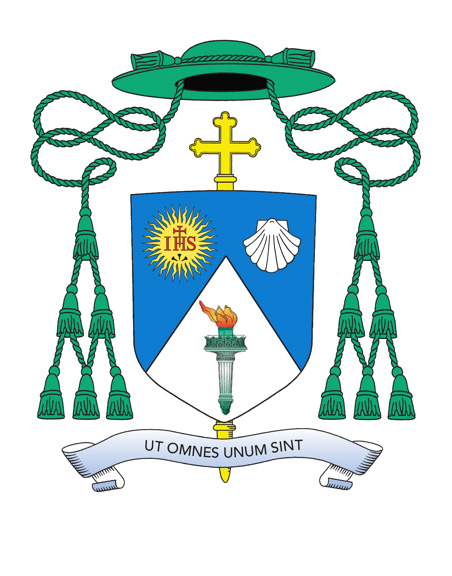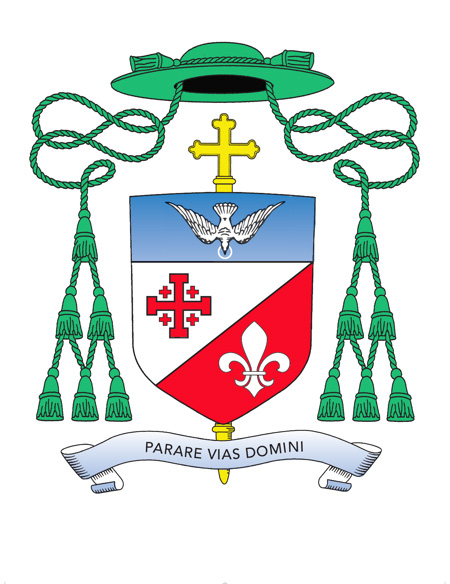By Very Rev. Michael M. Walters, J.C.L.
The family coat of arms – the art of heraldry – was developed in the Middle Ages as a means of identification in battle. In close fighting, an easily recognizable shield was essential for telling friend from foe.
As time went on, designs became more complicated and the use of heraldic designs moved beyond the battlefield so rules were developed and a group of experts called heralds came into existence to organize the system.
The Church adopted heraldry as a means of approving and authenticating documents as well as indicating ownership of church buildings. Bishops used their arms to decorate their episcopal thrones, vestments, coaches and tableware.
To this day, the bishop’s arms are used in official correspondence and the sealing of important documents.
In designing arms, the bishop would either use his family arms (as did the Medici and Barbani Popes) or adapt the family arms by changing a color or adding, removing or changing a symbol.
If the bishop did not possess a family coat of arms, one would be designed that referred to his personal history or things that are important to him. As the arms are described, it is important to remember that everything is described from the perspective of the person carrying the shield.
Finally, the shield is complemented by the episcopal hat and cross and the scroll bearing the motto. In ecclesiastical heraldry, the warlike helmet is replaced by the clerical hat called the galero. Once used as the ordinary headgear of clerics, the color and number of tassels indicate the rank of the wearer. The color for a bishop’s hat is green and it has six tassels on each side. The cross behind the shield is a processional cross usually carried before the bishop in church worship services.
The motto scroll is used to display either a scriptural quote or an aphorism which the bishop takes as a model for his ministry.
Bishop Massa

Bishop James Massa has adopted his coat of arms to illustrate both his history and his connection to the Diocese of Brooklyn. The elements of the shield refer to his personal history in life, in education and in ministry.
In the center of the base of the shield is a torch, modeled on the torch held by the Statue of Liberty in New York Harbor.
Bishop Massa was born in New Jersey but later moved to Brooklyn where he was ordained a priest in 1986. He has spent much of his life around the area over which the Statue of Liberty has shone her torch for generations to welcome the immigrant, the poor and the “huddled masses yearning to breathe free.”
Bishop Massa’s ancestors arrived in New York Harbor from their homelands in Italy and in Ireland at the beginning of the last century. The torch is also a symbol of faith drawing all people into the light of Christ, which both illumines and burns away the darkness of sin.
A product of a Jesuit education, Bishop Massa uses the Jesuit seal to give thanks for those opportunities as well as a tribute to Pope Francis, the first Jesuit pope and the pope who has nominated him to be a bishop, and to the late Cardinal Avery Dulles, S.J., who directed his doctoral studies in theology.
The symbol itself refers to Christ as the Sun in Splendor, hence the rays emanating from it. The reference to Christ is made explicit by the use of the monogram IHS, the first three letters of the word Jesus in Greek, the cross and the three nails. Passion, death and resurrection are all combined. As the Sun overtakes the darkness of the Earth, so the Son of God casts away the darkness of sin.
The remaining symbol on the shield is the scallop shell. The badge of the pilgrims who have travelled since the Middle Ages to the shrine of St. James (Santiago) at Compostela, Spain, the shell has a three-fold purpose.
First, it is the symbol of Bishop Massa’s patron, St. James, whose name he was given at Baptism.
Second, it refers to the First Church of the Diocese of Brooklyn, St. James Cathedral-Basilica in Downtown Brooklyn.
Third, it is a reminder of the sacrament of Baptism by which we become one with the Lord who calls us into communion with Himself and into the unity of faith and worship that pertains to the essence of the Catholic Church.
The colors of the shield are also significant. Blue and white are the traditional colors of the Blessed Virgin Mary, Queen of the Apostles, as well as the colors of Union Catholic H.S., Scotch Plains, N.J., where Bishop Massa began discerning his vocation to the priesthood.
The bishop’s shield is complemented by the episcopal hat and cross and the scroll bearing the motto “Ut Omnes Unum Sint” – “That All May Be One.” The motto is taken from the High Priestly Prayer of Jesus at the Last Supper, His final prayer in the company of His Apostles that makes of unity both a gift to the Church and a task ever to be realized by all believers. This motto represents Bishop Massa’s work in the ecumenical movement and his commitment to interreligious dialogue as the path to a more peaceful world.
Bishop Mroziewski

Bishop Witold Mroziewski has adopted his coat of arms to illustrate both his history and his connection to the Diocese of Brooklyn. The first elements are the colors he has chosen. The red and white in the main part of the shield are reminders of the colors of the flag of Poland, the bishop’s homeland. To these is added a panel which is colored blue. Tying the colors together, the shield displays the red, white and blue that is symbolic of the United States.
The top panel is charged with the image of a descending dove, a traditional representation of the Holy Spirit. On the blue field, it represents heavenly wisdom and grace which the bishop needs in order to be a wise, faithful and loving shepherd to the people he serves.
The red cross with the four crosses in the arms is called the Jerusalem Cross, which represents the five wounds of Christ and is a symbol of the resurrection. The Jerusalem Cross is the badge of the Knights of the Holy Sepulchre; as a member of the Order, Bishop Mroziewski is entitled to use the cross in his coat of arms.
The last symbol on the field is the fleur-de-lis (lily), which is a traditional symbol for the Blessed Virgin Mary. This represents Bishop Mroziewski’s personal devotion to the Blessed Mother and also a prayer that she will watch over him with a mother’s love.
The bishop’s shield is complemented by the episcopal hat and cross and the scroll bearing the motto “Parare Vias Domini” – “Prepare the Ways of the Lord.”
The motto reminds us that the bishop is called to the same mission as St. John the Baptist in helping to turn minds and hearts toward the salvation offered by the Lord.
Father Michael Walters is the director of the Pontifical Mission Societies for the Archdiocese of Newark, N.J. The artwork on each Coat of Arms was created by Sister Gerarda Panel, O.P.
